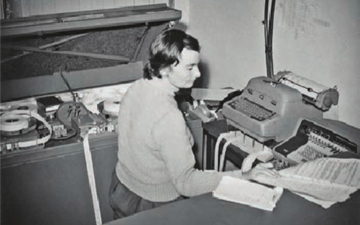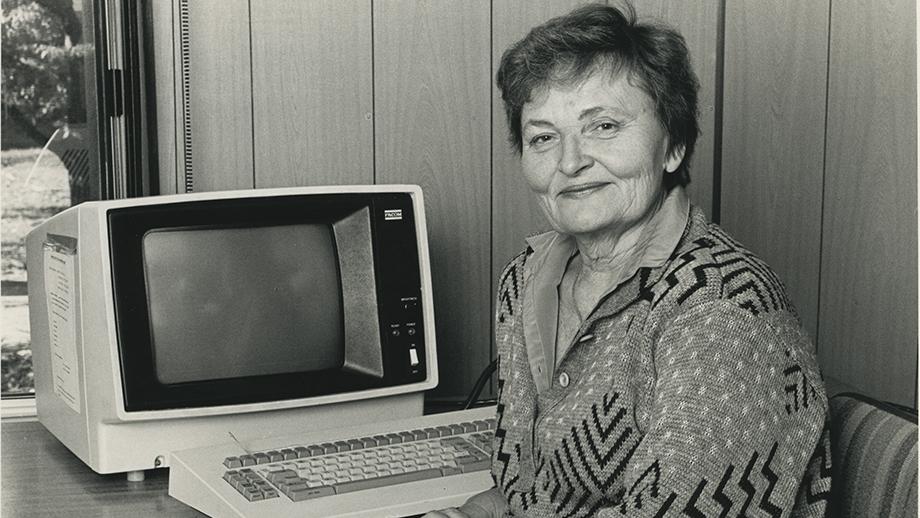To mark the 50th anniversary of computing at ANU, the School of Computing hosted a gala dinner at the National Gallery of Australia on 29 April, 2022.
David Thodey Keynote
In his keynote speech, David Thodey—chair of the CSIRO Board and former CEO of Telstra—spoke about the the impact of computer science on humanity.
Jubilee Joint Fellows
Prof Amanda Barnard AM announced the recipients of the Jubilee Joint Fellowship.
Alumni Laureates
Prof Tony Hosking, Director of the ANU School of Computing, announced the names of 15 Alumni Laureates selected to help tell a people’s history of computing at ANU.
The Alumni Laureates were selected from over 6,000 computing-related ANU alumni after having been nominated by their peers. Most of those recognised were in attendance at the gala. See a full list of nominees here.
Early History
 The first ANU computer was an IBM 610 installed at Mt Stromlo
Observatory in 1960. It was programmed by Claire
Wehner
(pictured right at Mt Stromlo in the 1960s) and Don Faulkner among
others.
The first ANU computer was an IBM 610 installed at Mt Stromlo
Observatory in 1960. It was programmed by Claire
Wehner
(pictured right at Mt Stromlo in the 1960s) and Don Faulkner among
others.
It was followed by an IBM 1620, leased by the Department of Theoretical Physics in 1962. The first ANU computer used for administrative work was the IBM 360/50 installed on the top floor of the Cockroft Building in the Research School of Physical Sciences in 1966.
In 1971, Computer Science was launched as a sub-department within the Department of Statistics. Computing at ANU has since become much more than a research facility for other disciplines. It is a discipline in its own right, one that has fundamentally changed our world. Computing is the lifeblood of our global society, as well as global commerce and industry.
Pioneers
Prof David Hawking recognised some of the pioneers of computing at ANU through the years.
In the Beginning
Dr Kenneth Le Couteur was a British physicist who, during World War II was recruited by the British government to serve in the Code and Cypher School at Bletchley Park codebreaker. Aided by Collossus, the the world’s first computer, Le Couteur joined the historic mission to break the German military’s Enigma code.
In 1956, Le Couteur came to Australia to serve as the foundation Professor of Theoretical Physics at the newly formed Australian National University in Canberra.
“When he came to Australia, he tried to get some money to lease a computer for the Department of Theoretical Physics”, said Prof Brian Robson, who was asked by Le Couteur to manage the first computer installed on the Acton ANU campus.
“He understood how important these things were”, Robson said.
Robson was asked by Le Couteur to manage the IBM 1620 when it arrived on campus in 1962. Robson recalls in the video above that most of the programmers of the IBM 1620 were women, and that they were paid the same salary as male programmers.
In 1966, ANU established a Computer Centre headed by Mike Osborne, and it operated an IBM 360/50 located on the top floor of the Cockroft Building. More powerful than its predecessors, the 360/50 allowed ANU to computerise administrative processes such as the payroll, as well as supporting research and teaching. The Data Processing Unit (DPU) was responsible for maintaining the administrative programs, punching the data, and running the programs on the 360/50 from midnight to 4 am.
By mid 1967, the computer was being operated around the clock. During the day, academics from various departments were afforded access to the IBM 360/50 to support their research. Administrative functions were processed only between midnight and 4 am. And any spare time during the night could be booked by suitably qualified academics and postgraduate students — the first to study computer science at ANU.
 Skaidrite Darius
(pictured right in 1988) oversaw operations during the midnight to 4am
shift. Darius “overcome entrenched gender biases to become DPU
Supervisor and was responsible for the successful operation of the
administrative processes, often being called in in the middle of the
night”, said Prof David Hawking,
author of the The History of Computing at
ANU.
Skaidrite Darius
(pictured right in 1988) oversaw operations during the midnight to 4am
shift. Darius “overcome entrenched gender biases to become DPU
Supervisor and was responsible for the successful operation of the
administrative processes, often being called in in the middle of the
night”, said Prof David Hawking,
author of the The History of Computing at
ANU.
When Computer Science was launched as a sub-department within the Department of Statistics in 1971, Dr Ray Jarvis served as Head. Peter Creasy transferred from the Computer Centre to lecture on Fortran programming, operating systems and compiler construction, and Antonio Cantoni lectured on numerical methods. Students in early courses ran programs on the IBM 360/50, the Univac 1108 acquired by the Computer Centre in 1972, and a Data General Supernova operated by the CS sub-department.
In the video below, Prof Hawking reflects on the arrival of the Fujitsu AP1000 supercomputer in 1986.
The supercomputer was worth $3,000,000 and was loaned to the University by the Japanese technology giant to show that English-speaking countries could make good use of their computers.
Hawking was tasked with figuring out how to get the enormous supercomputer into the building, and he writes in his book, The History of Computing at ANU:
I made contingency plans to have windows removed from the tea room and to hire a crane, but it turned out that the biggest component would just fit into the lift. Mind you, the main unit weighed about 950kg, close to the lift limit. When it was wheeled in, the lift dropped a few centimetres, and ANU and Fujitsu staff collectively held their breath hoping that it would stop at the right level on the top floor. Fortunately it did.
Hawking also recalls that the new home for the Department of Computer Science provided a “much-needed upgrade” with adequate accommodation for staff and postgraduate students in offices with windows. “The tea room was a warm and inviting space—many productive conversations took place there”, he said.
Below, Prof David Hawking solves the mystery of the “unmarked grave” next to the footpath leading to the Leonard Huxley Building.
When the last mainframe computer at ANU became obsolete, the computing staff decided to bury a circuit board in a nearby garden. No longer legible due to the ravages of the Australian sun, the epitaph on the marker had read as follows:
Fujitsu GS8400 1995 - 2006
11 years of continuous service
In memory of the Admin Mainframe ANUA,
She really served us well.
Whether she will be the last of her kind,
Only time will tell.

